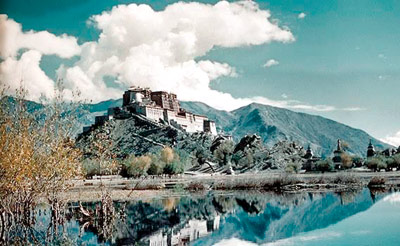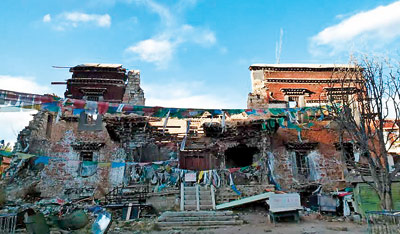A lament for Lhasa
View(s):
Lhasa in the 1930s. Left, the Potala Palace, right the Three Stupa Gate
The Tibetan character of this capital, once described as one of the most fascinating cities in the world has almost disappeared, writes Ven. Bhante S. Dhammika
In the 19th and early 20th century Lhasa, the capital of Tibet, was often dubbed The Forbidden City, The Vatican of Lamaism or The Abode of the God King by westerners.
These names and the fact that there were few first-hand accounts of the city since the early 18th century and no photos of the place all, added to its mystique.
China had been penetrated, India had been described and Japan was being explored; but the Tibetan capital remained unknown.
In 1628 two Jesuits, Fathers Cacella and Cabral got as far as Shigatze only a few hundred miles from Lhasa but were then turned back.
Finally the equally intrepid Jesuit Fathers Grueber and d’Orville got there on October 8, 1661. Their notes on and sketches of Lhasa were published in Latin in 1677.
Thomas Manning was the first Englishman to get to Lhasa in 1811 while on his way to China. In 1846 two more Catholic priests, Fathers Huc and Gabet, reached Lhasa and managed to meet the regent, explore the city and stay there for some months.
After this no westerner set foot in the place until 1904 when the Younghusband expedition invaded Tibet, pushed its way into Lhasa, forced the Tibetan government to sign a trade agreement and then withdrew.
Of course while Lhasa was forbidden to westerners, Buddhists from China, Mongolia and Ladakh, Sikkim, Bhutan and Buryatia in Russia had been going on pilgrimage to Lhasa for centuries.
Even some Japanese managed to get there; a Japanese monk Venerable Ekai Kawaguchi managed this in 1901. Tibet in general and Lhasa in particular was off limits to westerners because despite the Tibetans’ ignorance of the modern world they knew that one country after another in Asia had fallen to colonial powers and they were determined that this would not happen to them.
The attraction of Lhasa for Buddhists was its long history as a centre of Buddhist scholarship, its sacred temples and its location as the seat of the Dalai Lama, revered even by Buddhists other than those of the Tibetan sects.
It should be recalled that when Anagarika Dharmapala founded the Mahabodhi Society in 1891 the Dalai Lama became its chief patron. For westerners the very fact that they could not go to Lhasa gave the place a special allure.
In the second half of the 19th century a race developed between explorers of different countries to be the first to get there. The Swedish explorer Sven Hedin was obsessed with being the first to “unveil” Lhasa; he drove himself and his party so hard that several of his porters and a dozen of his camels died of exhaustion.
Despite this he failed. It was left to Francis Younghusband to win the prize in 1904, at the head of a 3000 strong army, supported by 7000 porters.
From then on until 1950 small numbers of westerners visited the city, mainly British diplomats, explorers, scientists or privileged guests of the Tibetan government. Nearly all of them reported how squalid the city was, in fact the fastidious Kawaguchi dubbed it “the citadel of filth”.
Younghusband described its streets as “mean and dirty” and L. A. Wadell reported that even the temples were “dark, dingy, filled with the smell of rancid butter from the innumerable butter lamps that kept burning in front of the idols, and overseen by scowling lamas”.
Of course, if Younghusband or Wadell had visited the slums in London’s Whitechapel or the Gorbals in Glasgow at the same time they would have found them equally filthy. And if the Tibetans had invaded and gone to St. Paul’s I suspect the archbishop would have scowled at them.
Yet, despite the dirt, all the visitors to Lhasa up to 1950 report that it was one of the most fascinating cities in the world, filled with ancient and unique sights to stimulate the imagination and enchant the eye.
There was the three elegant stupas forming the gateway to the city (Pargo Kaling), the Dalai Lama’s Summer Palace (Norbulinka) set in beautiful gardens, the huge Sera Monastery that housed 500 monks, the Ramoche Temple, the Turquoise-roofed Bridge (Yutog Zamba), the enchanting Dragon Pavilion (Lukhang) on an island in the middle of a lake bordered by gnarled and ancient trees, the city’s main temple The Jokhang built in the 8th century and filled with ancient treasures, to name but a few.
But outdoing all these in size and splendour was the Potala Palace. With its soaring, inward-sloping walls and stairways, its contrasting red and white towers and its golden spires, it is one of the most majestic buildings ever conceived, a true architectural marvel.
And with the snow-capped mountains as a backdrop and its golden spires and roofs reflecting the sun and shining in the clear air (Lhasa is at 3490 metres above sea level) the whole literally takes one’s breath away when first seen.
Just as the kings of Kandy succeeded in keeping colonial powers at bay with the help of nature (preserving the thick, leech-infested, road-less jungles on the borders), so too the Tibetans preserved their independence with the help of the daunting and snow-bound Himalayas.

The Summer Palace of Tibet’s regents before its recent demolition
But in both cases the isolation could not be maintained forever. In the case of Tibet the danger did not come from the British to their south but the Chinese to their north. On October 6, 1950 the Communist Chinese invaded the country.
For the next few years they successfully disguised their true intentions, but when the Tibetans revolted in 1959 those intentions, to dismantle Tibet’s unique Buddhist culture, became only too apparent.
The subsequent crackdown was swift and brutal. But worse was to come during the so-called Great Cultural Revolution (1966-76).
In an orgy of destruction and violence, temples were dynamited, Buddha statues smashed, monks and nuns humiliated, imprisoned and murdered; and not just in Tibet; China’s cultural heritage suffered a catastrophe too.
I managed to get to Lhasa in 1985 just as China was opening up. The whole city looked like a rubbish dump. In the main shrine of the Ramoche Temple the statue of the Buddha had been destroyed and replaced by a garish one of Mao Zetung.
In the mournful ruins of the once grand Drepung Monastery I saw dozens of bags of small bronze Buddha statues being weighed on a large pair of scales, probably to be sold off as scrap metal.
I went to a stinking public urinal only to find that it had been paved with prayer stones, the stones Tibetans inscribe their Pirit sutras on.
There were even plans to dynamite the Potala Palace but this was abandoned at the last moment, supposedly because of the intervention of China’s Premier Zhou Enlai.
Despite the neglect and destruction the old city was mainly intact; the Chinese buildings, mainly ugly barracks-like constructions had been built around it.
Then I visited Lhasa again in 2009. What a difference! The city looked fairly clean, modern and many times larger than it had 14 years earlier.
There was only one problem – it looked like any of a thousand artless, nondescript modern Chinese cities. Only small pockets of the distinctive Tibetan-style houses were left and even these are now rapidly being replaced by cement block flats, tasteless shopping malls and barren car parks.
Even buildings of historical importance are being demolished. Just recently the Summer Palace (Shide Drokhang) of the former regents of Tibet, damaged during the Cultural Revolution was bulldozed rather than repaired.
Temples such as the Jokang, the Lukhang and the Ramoche have now been repaired and are in good condition but they have been reduced to little more than tourist traps; Buddhist worshippers are pushed aside so that Chinese tourist can take photos.
I spent several hours looking for the lovely Turquoise-roofed Bridge only to eventually find it behind a supermarket hemmed in by other modern buildings.
But it is not just the disappearing of the old but what the replacements are being used for which is contributing to Lhasa’s destruction.
In 2009 it was estimated that there are now over 1000 ‘massage parlours” in the city catering to the huge influx of predominantly male Chinese workers.
What was once a city of Dhamma is, as one report recently said, “rapidly becoming the sleaze capital of China.” Habitat International has recorded the destruction of the city’s significant buildings in its 2013 publication ‘The Traditional Lhasa House; The Typology of an Endangered Species’. It makes very sad reading.
The Chinese government is extremely sensitive about its rule in Tibet and tries to justify it in a most curious way. Official publications and websites endlessly recount how backward Tibet was before the Chinese takeover and how much they have developed the country.
This is exactly how colonial powers in the 19th century justified their rule in Sri Lanka, India and numerous other places. Responding to criticisms of the destruction of old Lhasa, the chairman of the Tibet Autonomous Region recently said: “We have spent millions of yuen on developing Lhasa.
The city has facilities it never had before such as electricity, rail connection, garbage collection, clean water and so on. The city is hardly recognizable from how it used to be.” This is quite true, although the same could be said for most other cities in the world.
It is also true that it is almost unrecognisable; its Tibetan character has been almost completely erased, its traditional architecture has almost disappeared, and its religious role had been replaced by commercial and tourist ones.
I am reminded of General Westmoreland’s notorious comment about Hue in 1968: “We had to destroy the city in order to save it.”


